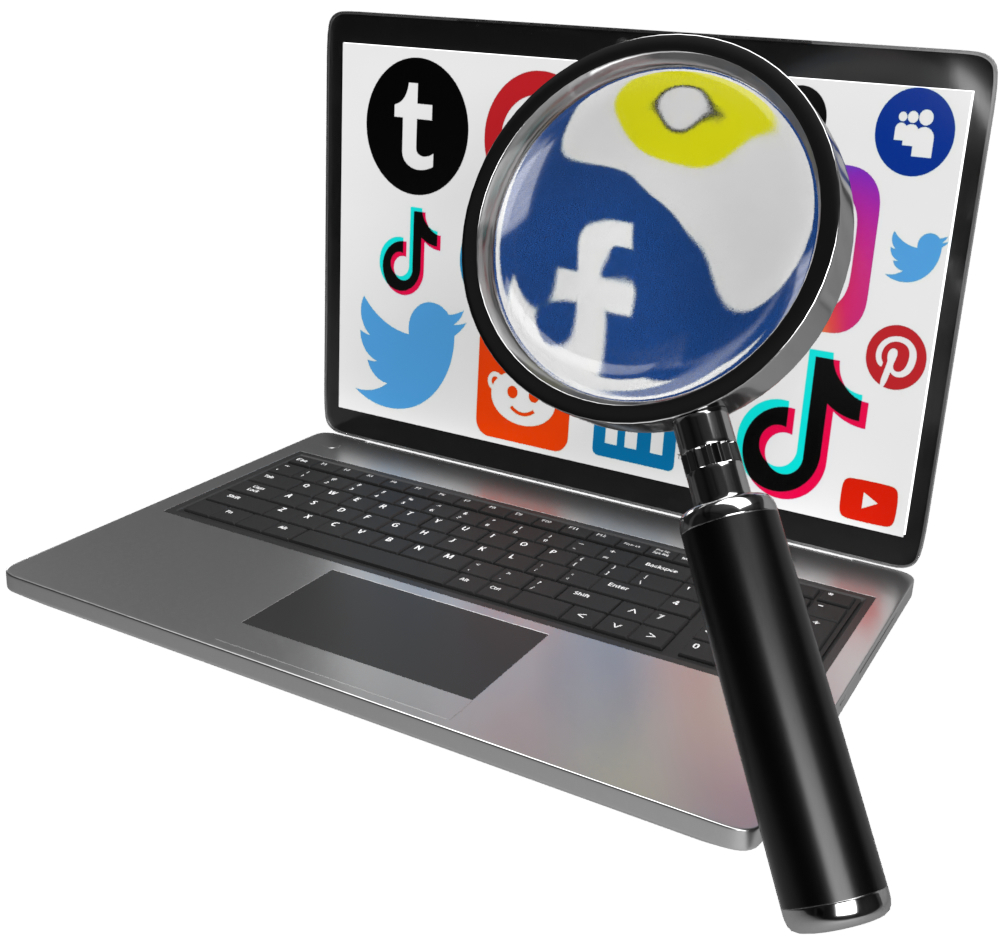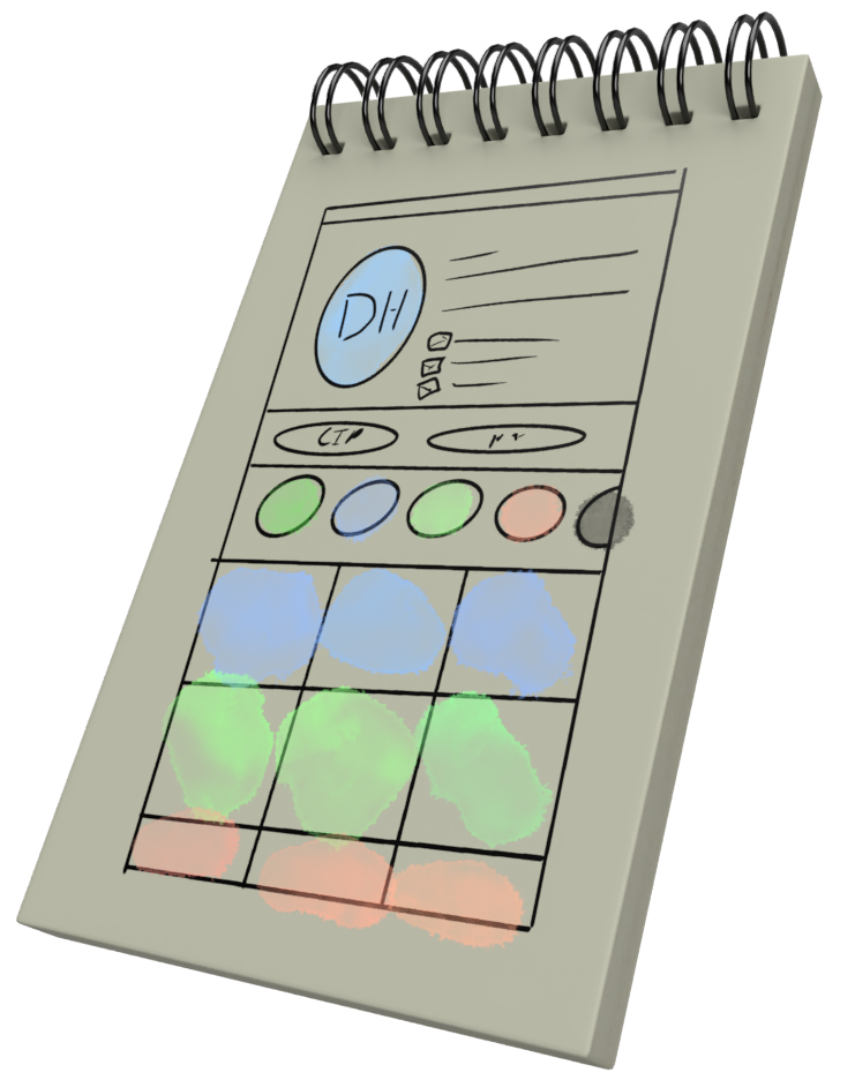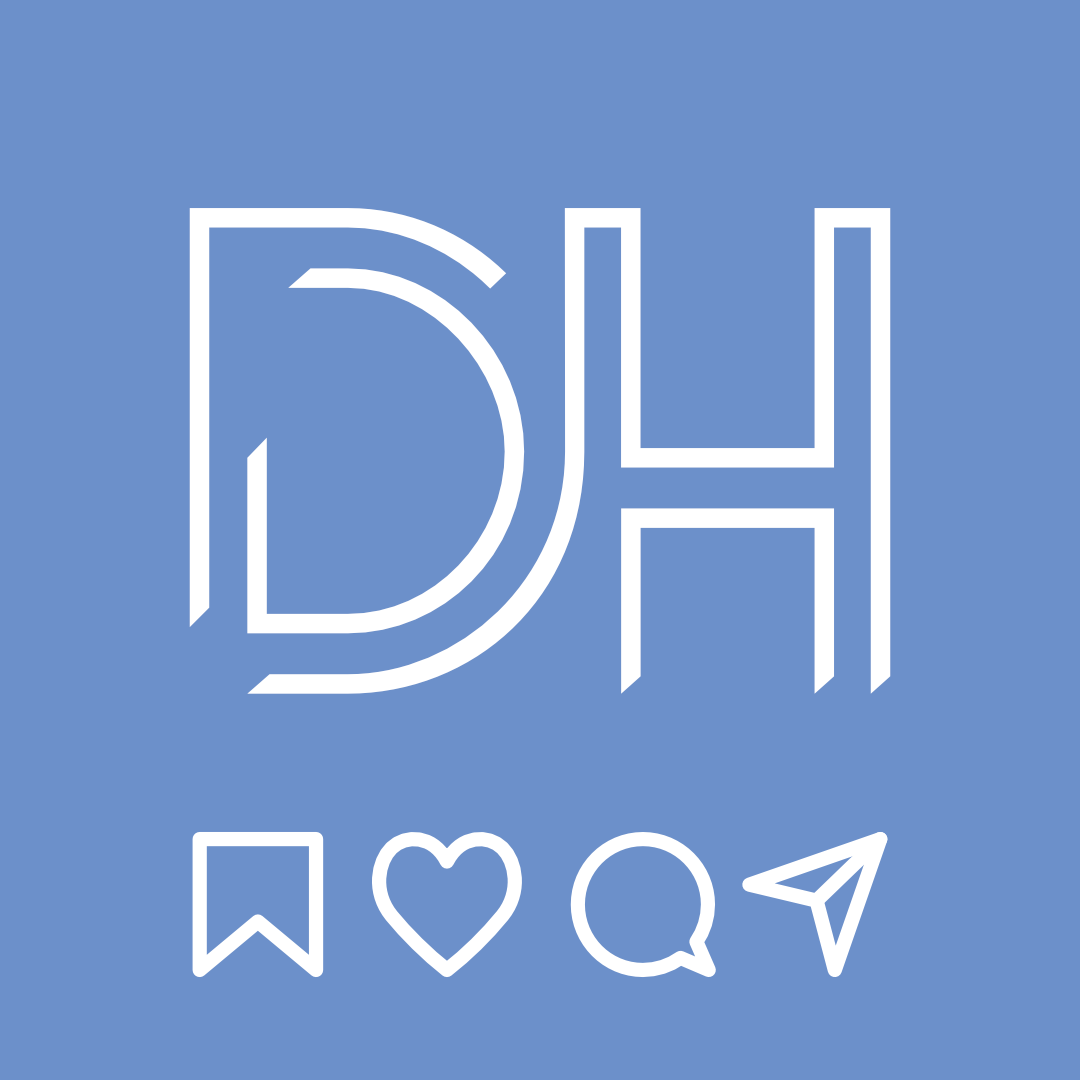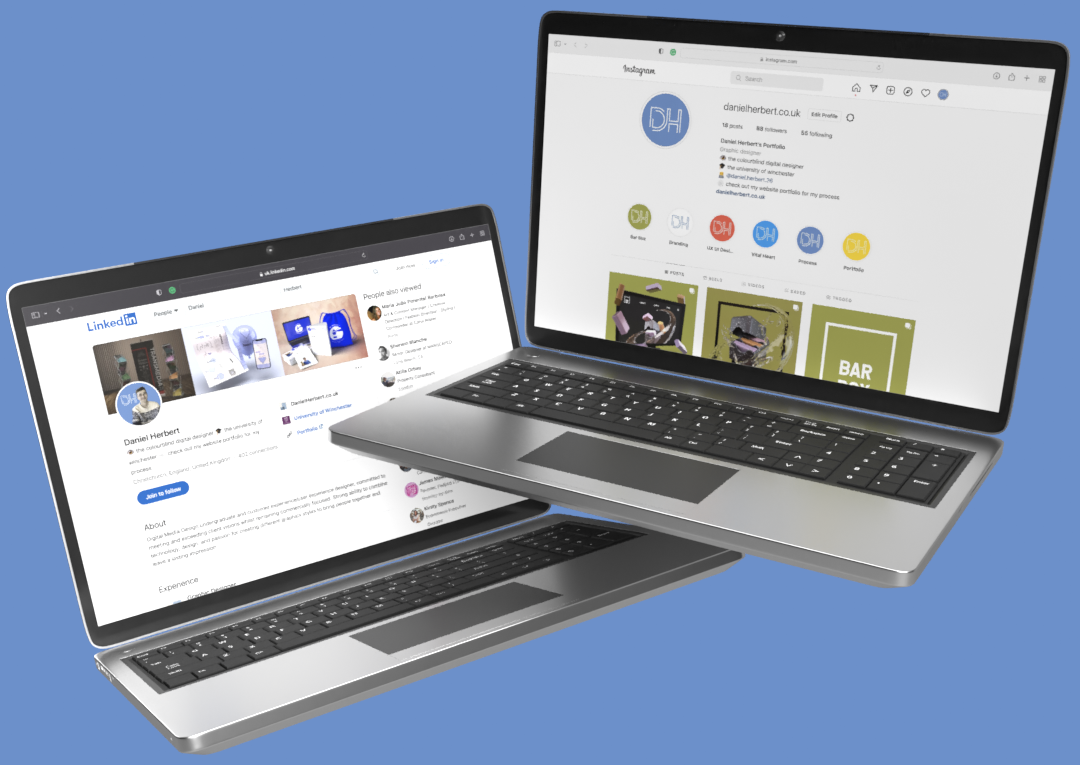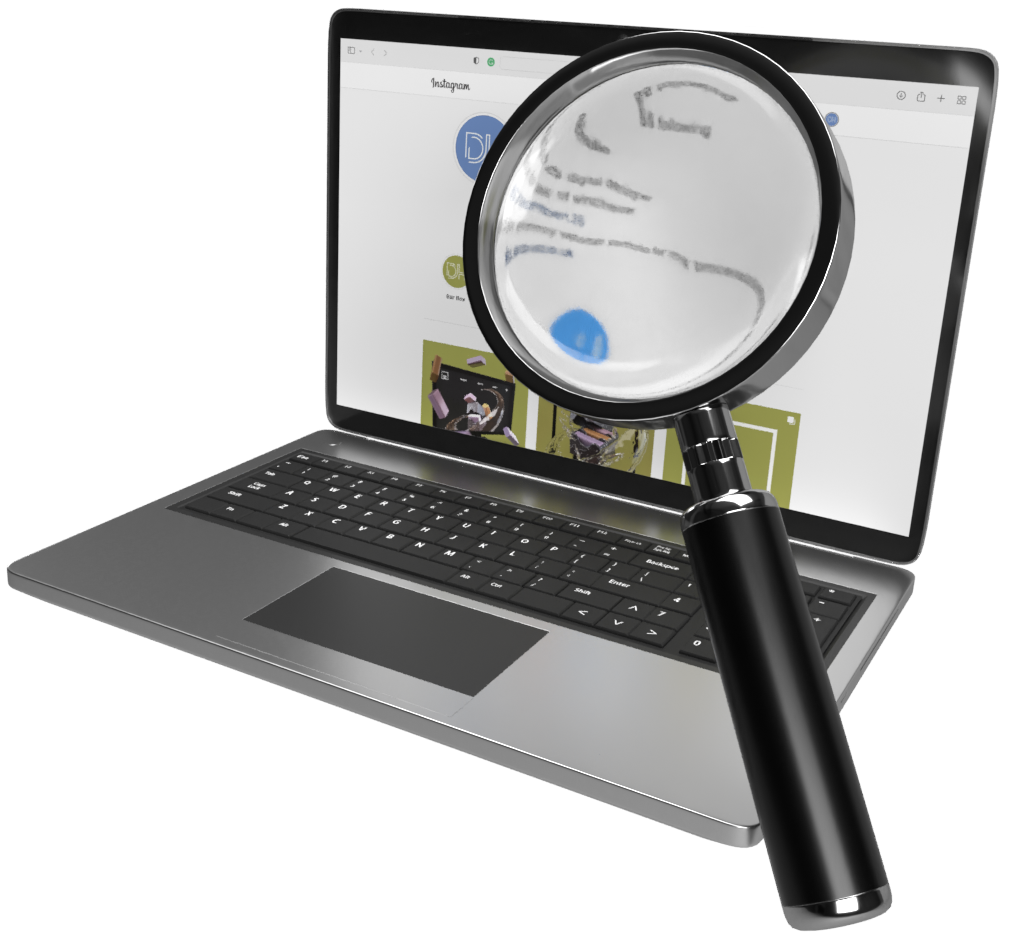Background and Research - Why Instagram and LinkedIn? My Inspiration
Project Scope: 2 Weeks
Project Type: Research
Role: Researcher and Communications
Discover more about how I researched Instagram, LinkedIn and other social platforms.
Initial Plans and Ideas - What led me to creating my style, wireframes and plans for my socials.
Project Scope: 3 Week
Project Type: Planing and Initial Ideas
Role: Planner and Designer
Tools: Preview, Facebook Creative Suite, Adobe: Illustrator and Photoshop and Affinity: Designer, Photo
Discover more about my initial plans and ideas.
Branding - How I Created my Personal Brand and Logo
Project Scope: 2 Weeks
Project Type: Design and Brand Thinking
Role: Designer
Tools: Adobe: Photoshop and Illustrator, Affinity: Designer
Discover more about the branding of my socials.
Posting and Interacting - How I posted on Instagram and LinkedIn and how communicating and connecting with others helped me grow
Project Scope: 4 Weeks
Project Type: Communications
Role: Communicator
Tools: Instagram, LinkedIn, Preview, Facebook Creative Suite and Previous Research
Discover more about the Product Design of the Bar Box.
Analysis - How have my socials helped me
Project Scope: 2 Weeks
Project Type: Data Analyst
Role: Social Media Data Analyst
Tools: Instagram, LinkedIn, Google Analytics
Discover more about the Analysis of my social media project
The Brief
We were tasked with creating a social media campaign for our portfolio websites and advertising ourselves. I set personal goals for this project, which included increasing the number of my followers to a specific amount, increasing traction to my portfolio website and increasing the reach of my posts. Once I researched which social media works best for a digital multimedia designer, I used Instagram and LinkedIn as my two primary forms of social media.
Background - Why Instagram and LinkedIn? My Inspiration
Why Instagram?
Instagram is particularly relevant and robust for scaling personal brands. In my opinion, it's one of the most effective places to show your best self to the world. Launched in 2010, Instagram has become a landmark for individual brands and organisations. While many might think of Instagram only as a place to show off your vacations, pets, and selfies, it offers plenty of opportunities for you to showcase your work and your core values. Graphic designers can display their latest products in a visually-appealing way; content creators can share new posts by linking to their website, digital marketers can make it clear they know how to engage an audience, and salespeople can make it evident that they know how to make anything look appealing, and the average professional can use it to boost their likability and hire ability.
17.9% of global IG users are men between the ages of 18-24. In terms of social media demographics, more than half of global Instagram users are aged 34 years or younger. The largest age group is 18-34 years old, consisting of 62.2% of all users. 50% of Instagram users visit a website after seeing it in Stories. If your goal is to drive action to your website, Instagram find that "50% of Instagrammers have visited a website to buy a product/service due to seeing it in Stories." Being able to add a product tag to the post makes it easier for consumers to visit your website.
Why LinkedIn:
Famous for its networking ability, LinkedIn has been used widely around the globe for over 18 years, with now currently over 722 million members. With over 76% of LinkedIn users coming from outside the United States of America, LinkedIn offers globally one of the most diverse platforms and gives very good opportunities for networking.
LinkedIn is famous for both employers and employees. You can engage with a range of people from different industries and create a custom profile to reflect the attitudes and your ideas, charisma and aims, which could include: getting a job, finding clients, finding employees, creating and sustaining connections.
With a change in career strategy, people are changing jobs much more frequently with over 40% of all LinkedIn users changing their jobs, companies, or industries every four years. In comparison, 60 years ago most people expected to remain working for the same company for their entire working life, progressing within the company through internal promotion. Forty million people use LinkedIn to search for jobs each week. If you are a company hiring, you will be able to search by crucial skills, soft skills, software skills, and many other granular searches. This enables employers to head-hunting specific employees. As a result, three people are hired through LinkedIn every minute. When the pandemic hit, becoming an online and remote company became much more accessible, affordable, and realistic, increasing the total number of LinkedIn connections by 55% in 2020 alone. One of the reasons for this was that people wanted to explore career changes, either through choice or necessity due to redundancy because of the pandemic. In the design industry, however, many companies were already using LinkedIn and using online virtual meetings, to share documents and information. LinkedIn has supported the connectivity between people adding weight to the saying - it is more about whom you know, not what you know.
By creating connections with people in similar industry around the globe LinkedIn offers one the opportunity to broaden knowledge of available jobs and other industry-standard software. Being able to offer a client the choice of either website design or 3D modelling for example gives a much wider range of potential clients. This would be a form of outsourcing as one could organise and profit from a client whistle not undertaking the design work.
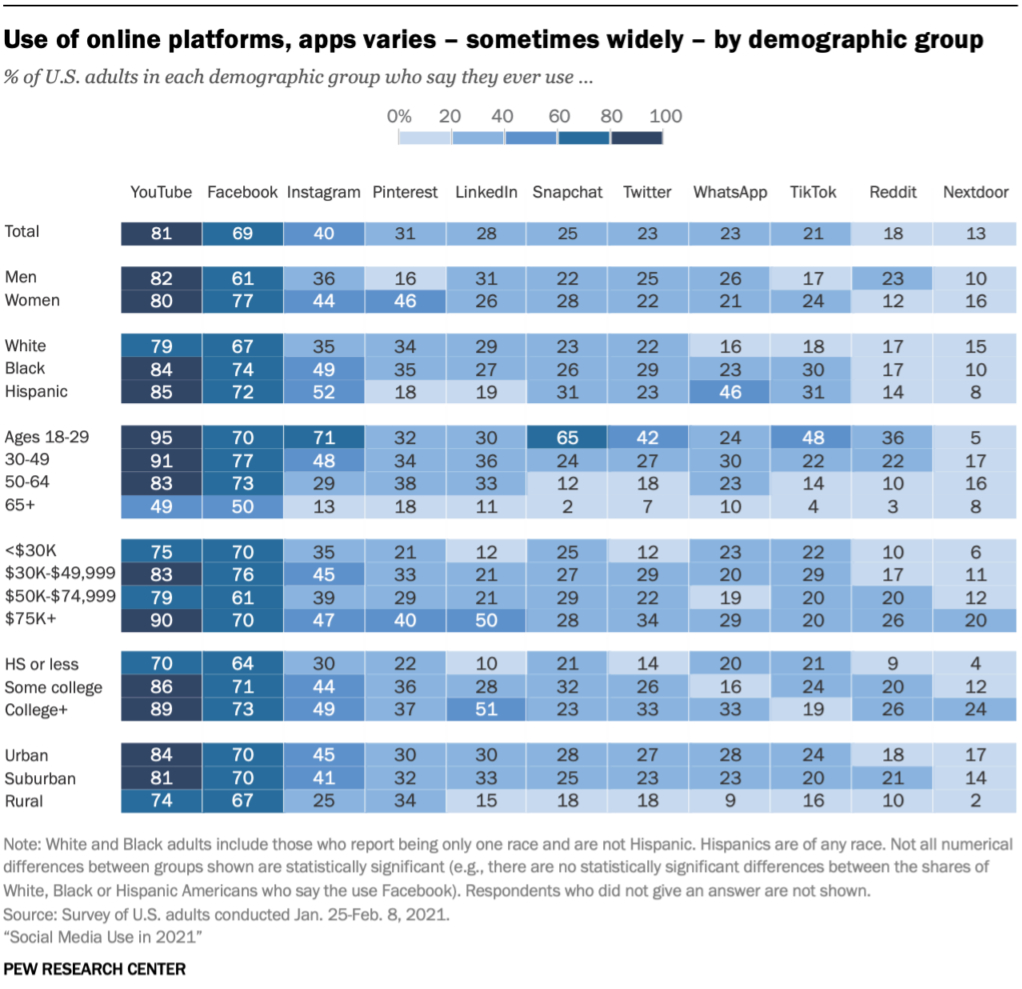
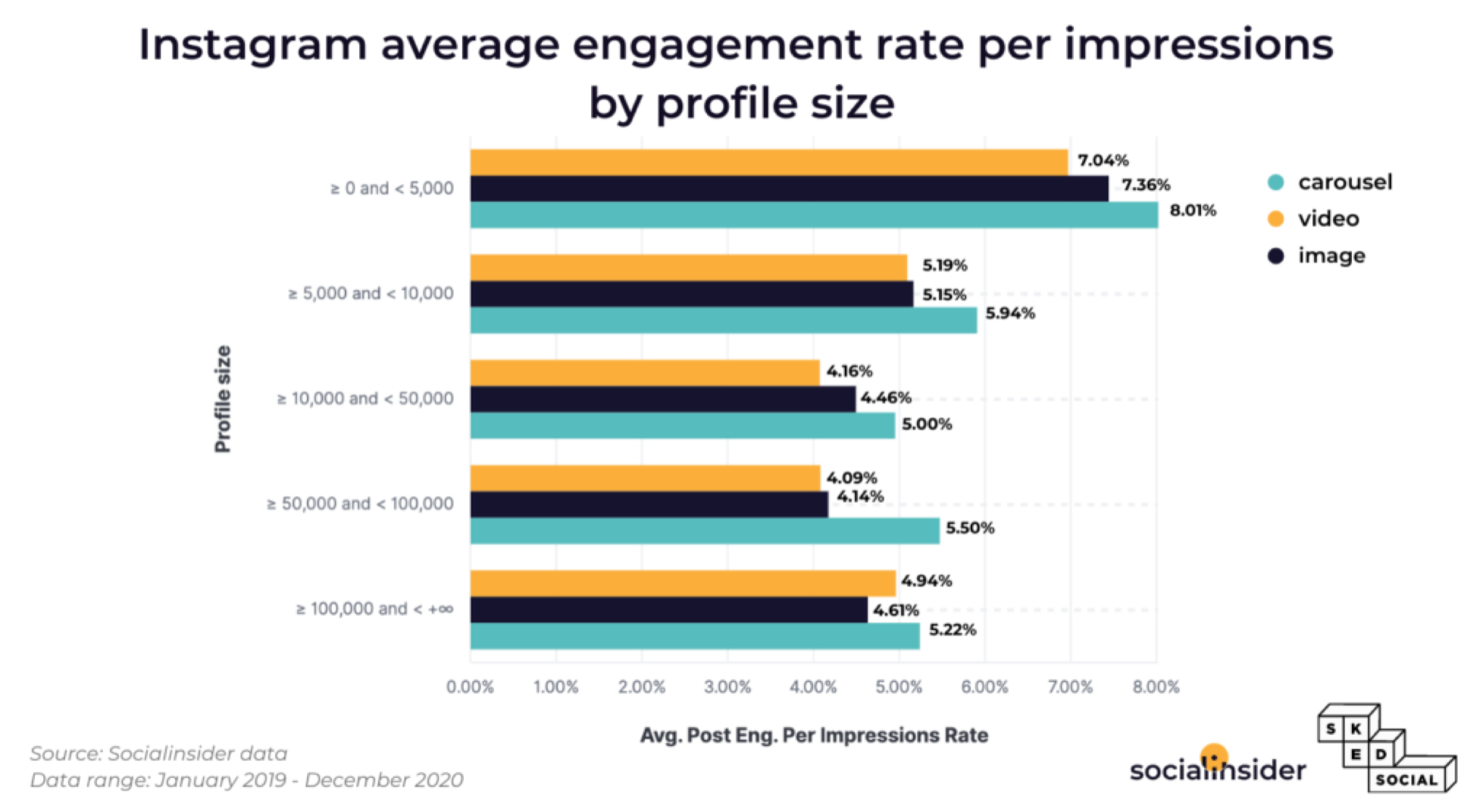
Once I decided on using Instagram it was important to break down the trends and strategies used by professionals every day. I first looked into the different types of posting which include: single-image posts, carousel posts, video posts, reals, IGTV and stories. Each of these has its benefits and disadvantages. In the previous graph, it is clear to see that carousels perform best with engagement, as the posts are been shown again, multiple times to the same user. Each time the user logs back in, if they haven't liked the image, it will show them the first image in the carrousels then the second, third and so on.
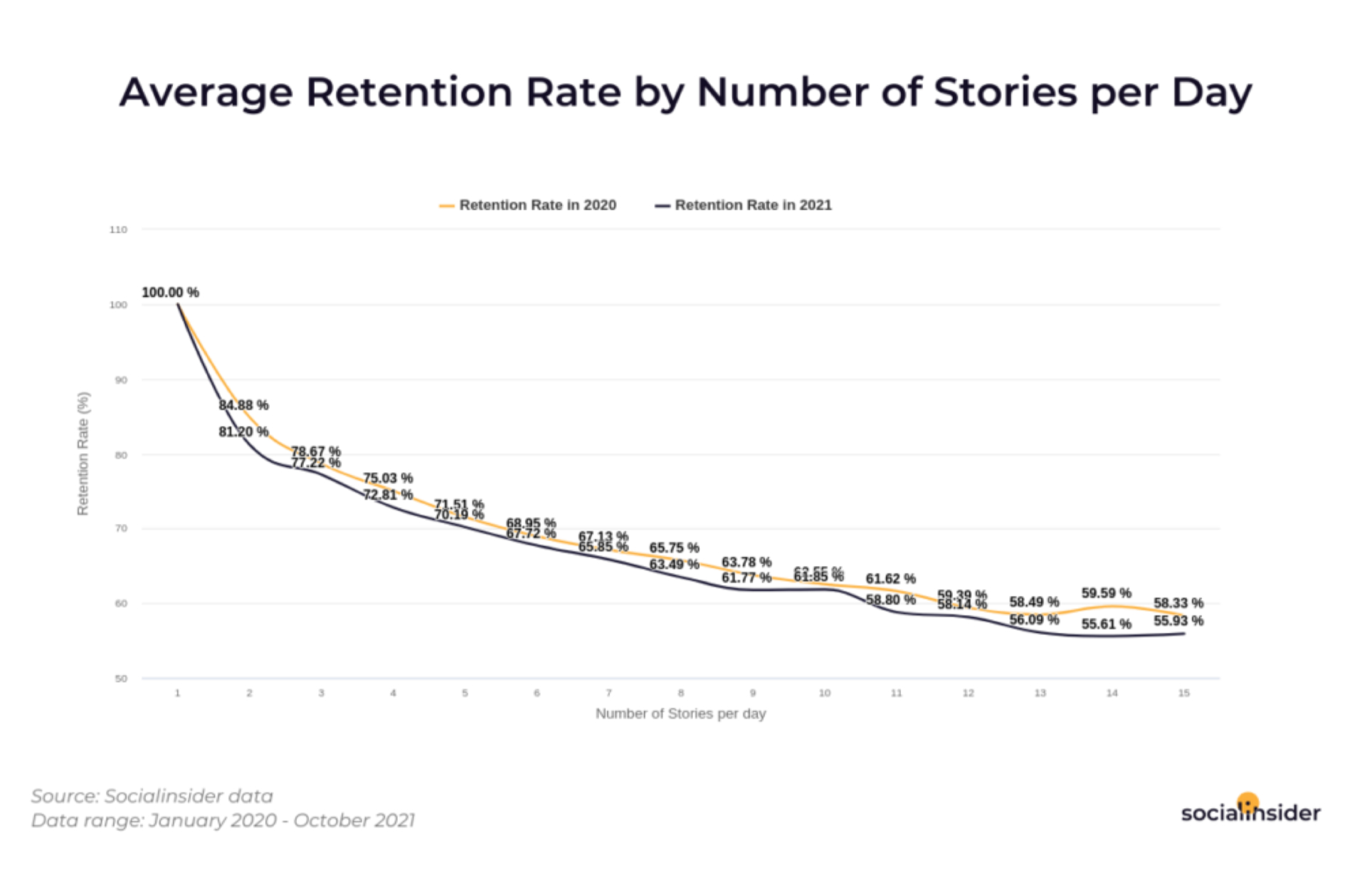
Another media Instagram is well known for is its story features. Stories can be images, videos, links, stickers, or selfies that any user can post, lasting for 24 hours.
It's good to note that the interaction and retention of a viewer exponentially decreases when more stories are posted in one-day. Stories could also be saved as highlights which show up at the top of a users profiles, which is a great way to show the user snippets of a project or someone's personal life.
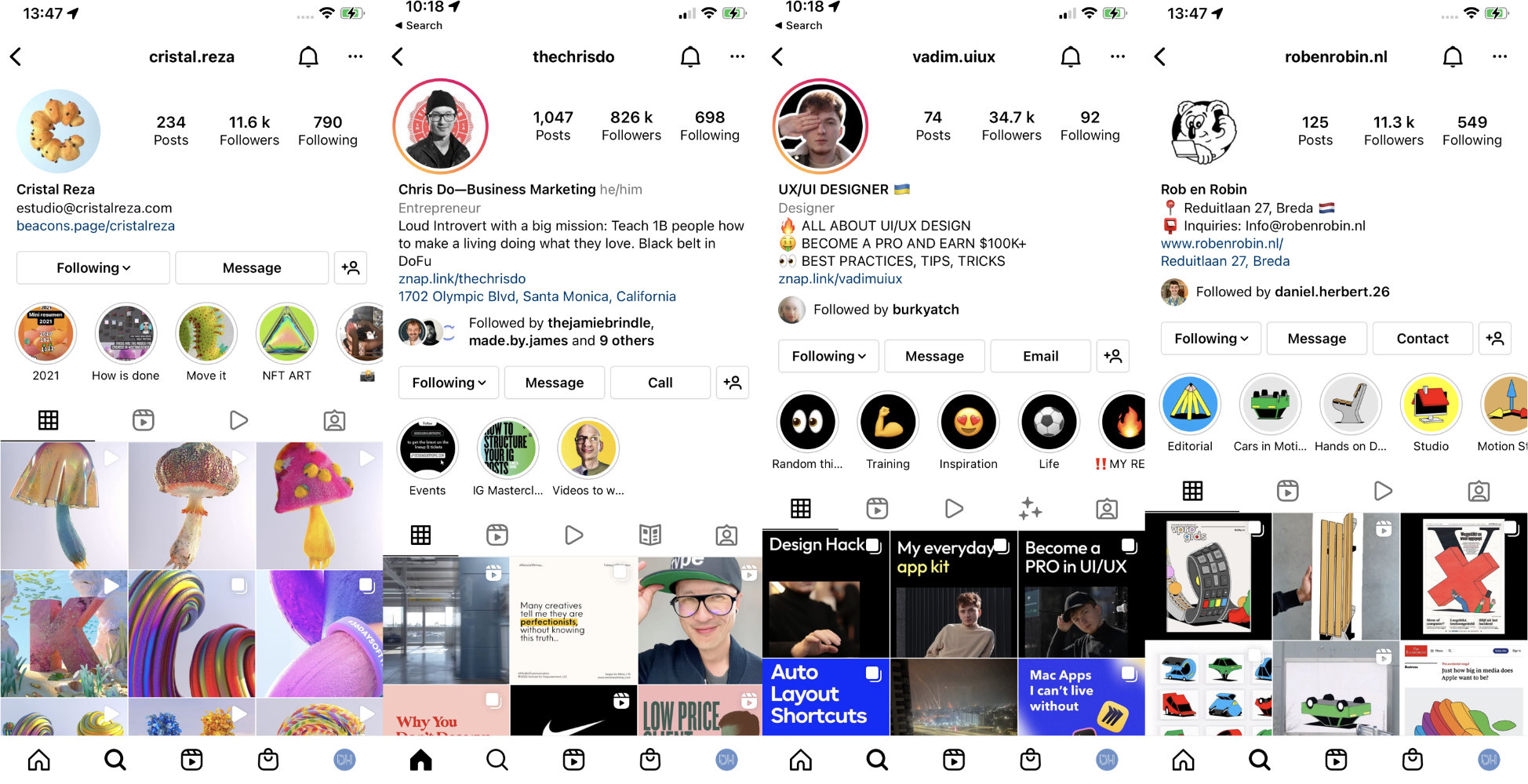
Many different professionals inspired me. When it comes to Instagram, I looked at four accounts. I tried to understand how they became so successful and how their aesthetic is pleasing. Focusing on Rob en Robin, two Dutch designers who have a specific style of 2D motion design standard in Scandinavian countries. They use a technique to create a 3-D model in Cinema 4D, create realistic animations, export them as frames, and turn them into incredible 2-D motion graphics.
Cristal Reza makes some of the most incredible 3-D motion graphics on Instagram. Using Cinema 4D and other 3-D programs, creates life-like movement with detail and textures like fur and other photorealistic textures. Both of these creators use every type of media that Instagram offers, from reels to highlights. This enables them to engage with new audiences using reels and keep connected with their audiences using posts, carousels and IGTV.
.
Initial Plans and Ideas - What led me to creating my style, wireframes and plans for my socials
I created a Gantt chart to manage all the different steps that I needed to undertake this project. I created an excel spreadsheet that adapted to the inputs I had and that could be used over a variety of projects. The spreadsheet had a column for the priority, the completion rate as well as the progress. I found outlining all my steps at the beginning of the project allowed me to continue on with different tasks without losing my train of thought. On reflection, I should have started this earlier as I, unfortunately, left this to the sixth. The Gantt chart allowed me to critically analyse how much work I have to do and how much I can do.
I understood that the social aspect was an important part of the social media project. I planned to utilise LinkedIn to allow me to create connections with individuals and possibly receive placement offers from industry professionals for Year Three. I wanted to talk to as many creative individuals as possible, but I also understood that quality over quantity is more important in some cases. This is why I planned on talking to creators I had a real passion for and interest in their design work or in their company's work.
I then had to make sure I was setting time aside to work on my communications and in LinkedIn's case made it a priority over posting my own work.
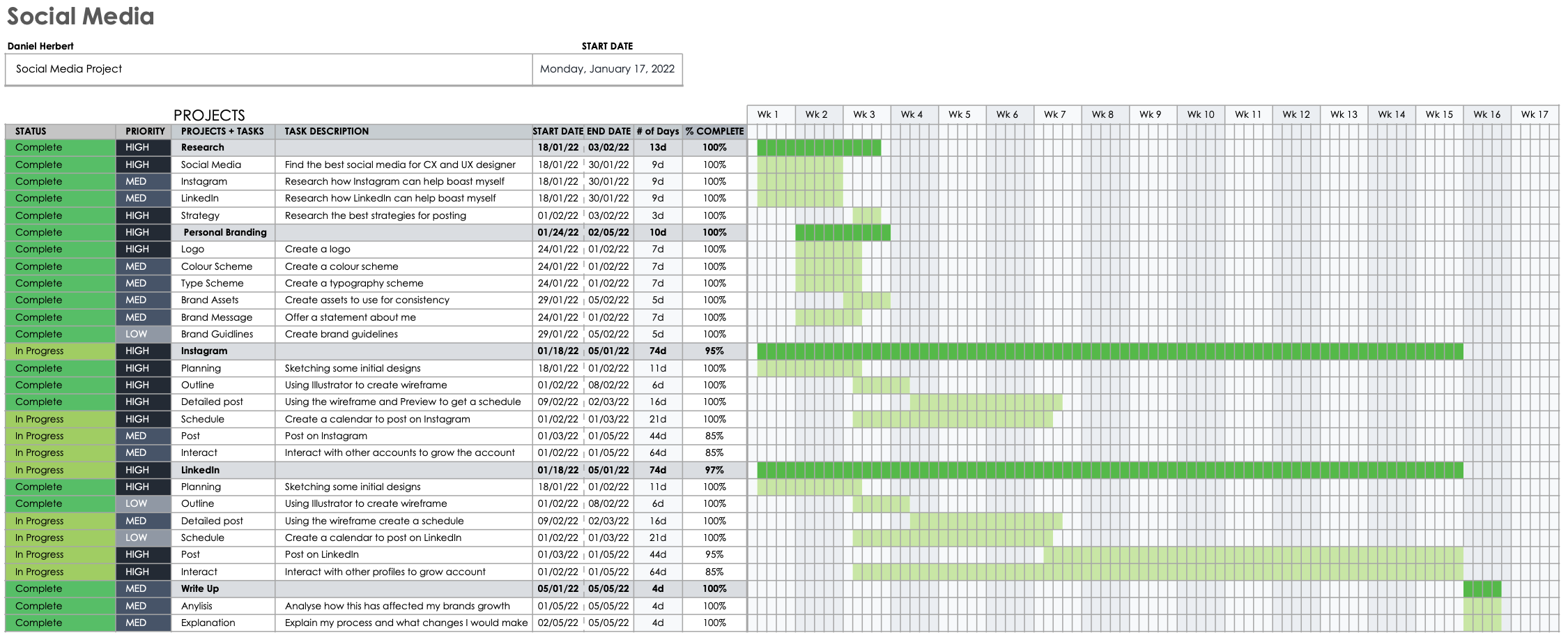
I started by creating a schedule for my posts, primarily on Instagram. My program consisted of 6 weeks worth of work. By researching, I found that posting continuously at a set time every day increased initial engagement, and on a long-term posting, Tuesdays, Wednesdays and Thursdays retained engagement. I then decided to post daily for the first week and three times weekly for five weeks.
I compared many different scheduling programs and software and narrowed it down to Preview and Facebook Creative Suite. Preview allowed me to schedule posts easily and view their layout on Instagram like mock-ups. Facebook Creative Suite gives more freedom on the actual post creations such as cover photos for videos and posting automatically. I decided to go with Preview because it allowed me to appreciate my profile once I finished the six-week course.
Branding - How I Created the my Personal Brand and Logo
A vital part of this project was my branding. I've previously designed a brand for myself, including a signature and a photo. The signature was the logo itself and was used as an icon. On reflection, I found that this did not attract the clients and potential business partners I want to meet.
By designing a new logo that better reflects me and my design styles, I believe I can represent my work more effectively using this logo. The logo consists of a few sweeping lines using the gestalt theory of filling in spaces. By using sharper edges, my initials, one colour, readability and consistency, I believe I put together a logo that reflected my design style.
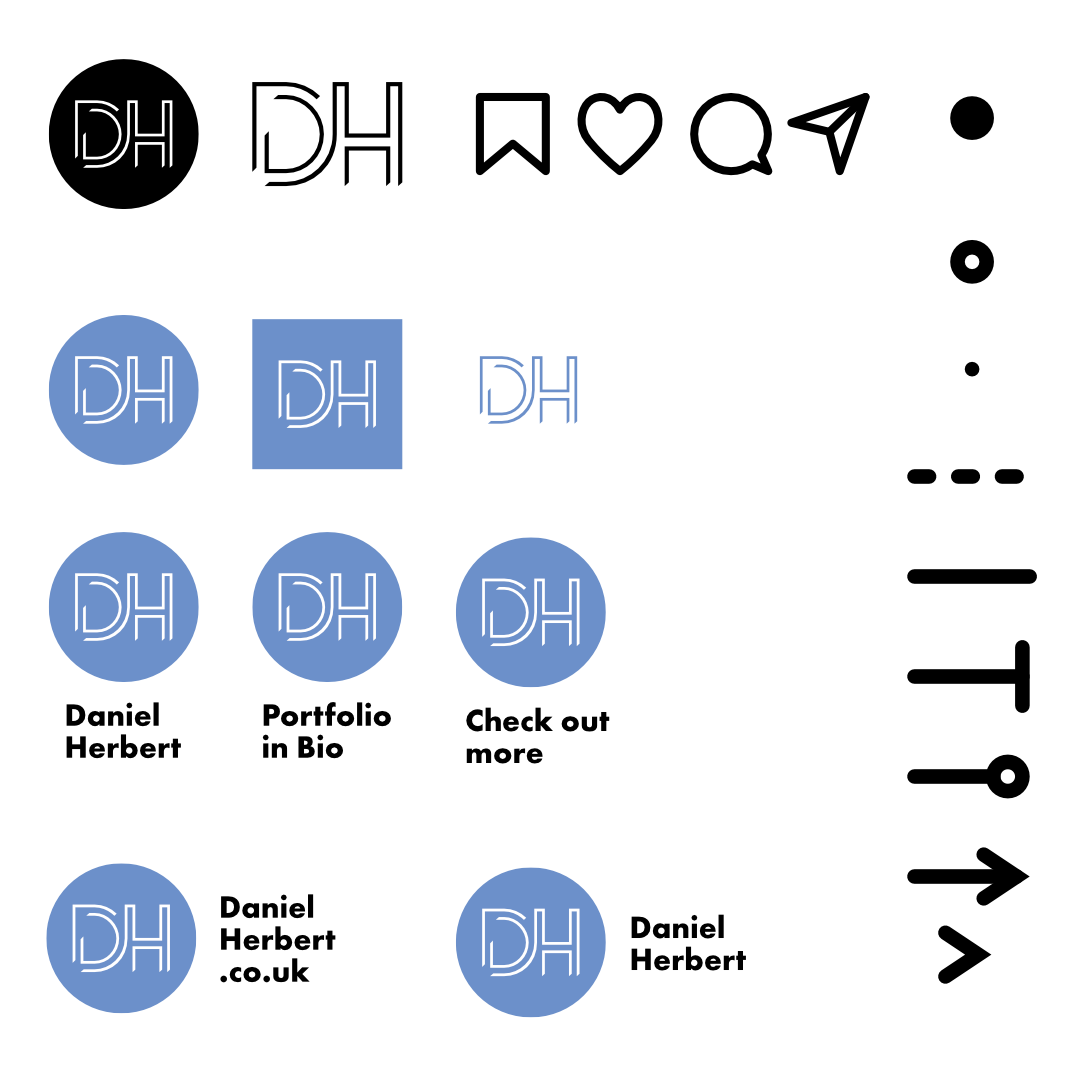
It wasn't only the logo used in my branding; I also created colour schemes, typography schemes, and assets on posts and my website. By having consistency throughout different platforms, portfolios and business cards, I can demonstrate my brand more effectively. I researched many individuals who work in the industry that I aspire to be in, UX and CX design; I found that simple icons were used by brands and individuals who specialise in clean, simplistic and aesthetically pleasing designs.
I also used basic colour theory for my primary colour, the shade of blue used by tech and design agencies, which matches my web design message.
A key part of my overall branding was my live CV. I created a new CV from the ground up to match my new guidelines and with help from The University of Winchester's Careers department as well as my lecturers. I completed a CV that I am now very pleased with.
Posting and Interacting - How I posted on Instagram and LinkedIn and how communicating and connecting with others helped me grow
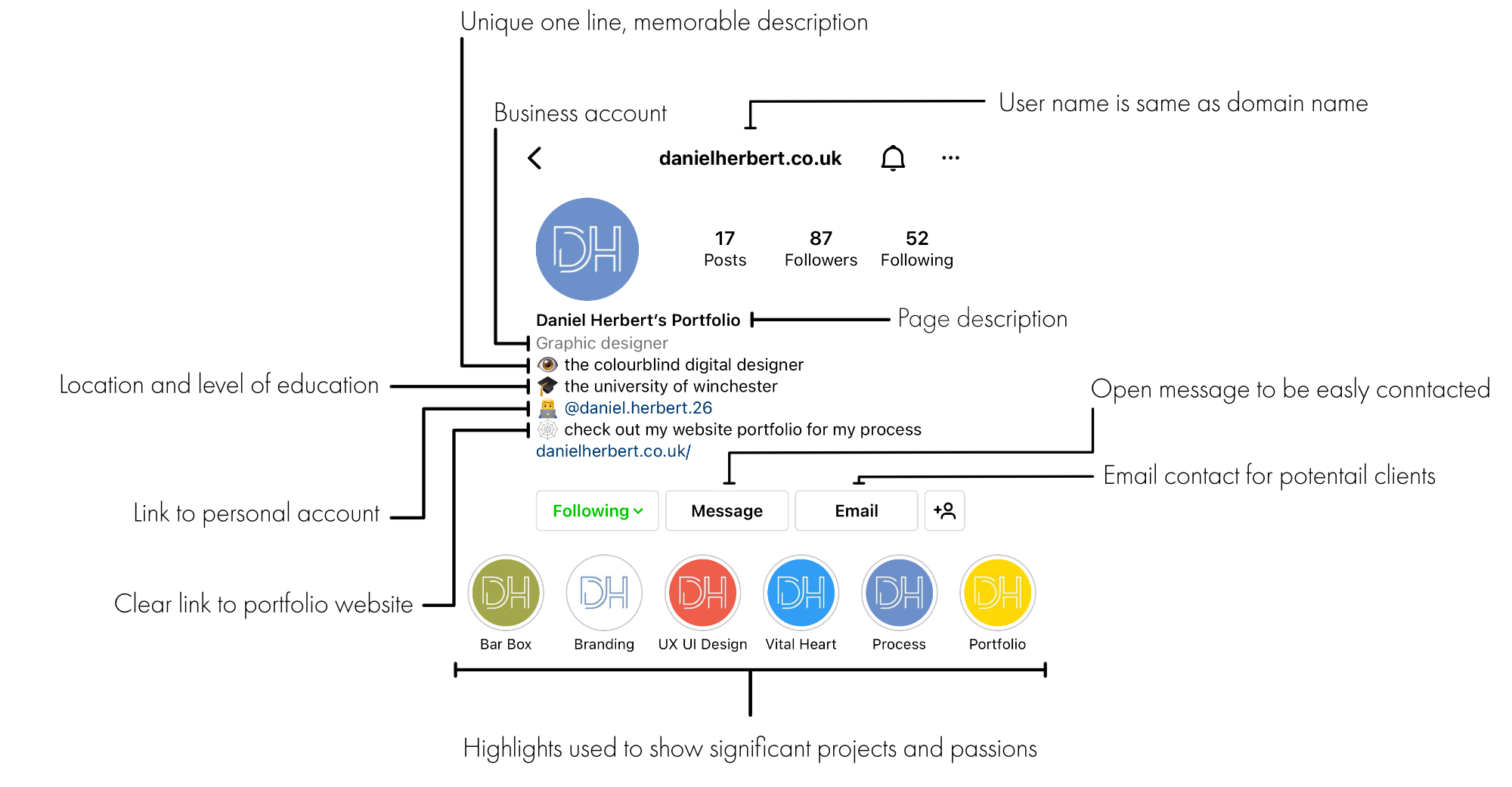
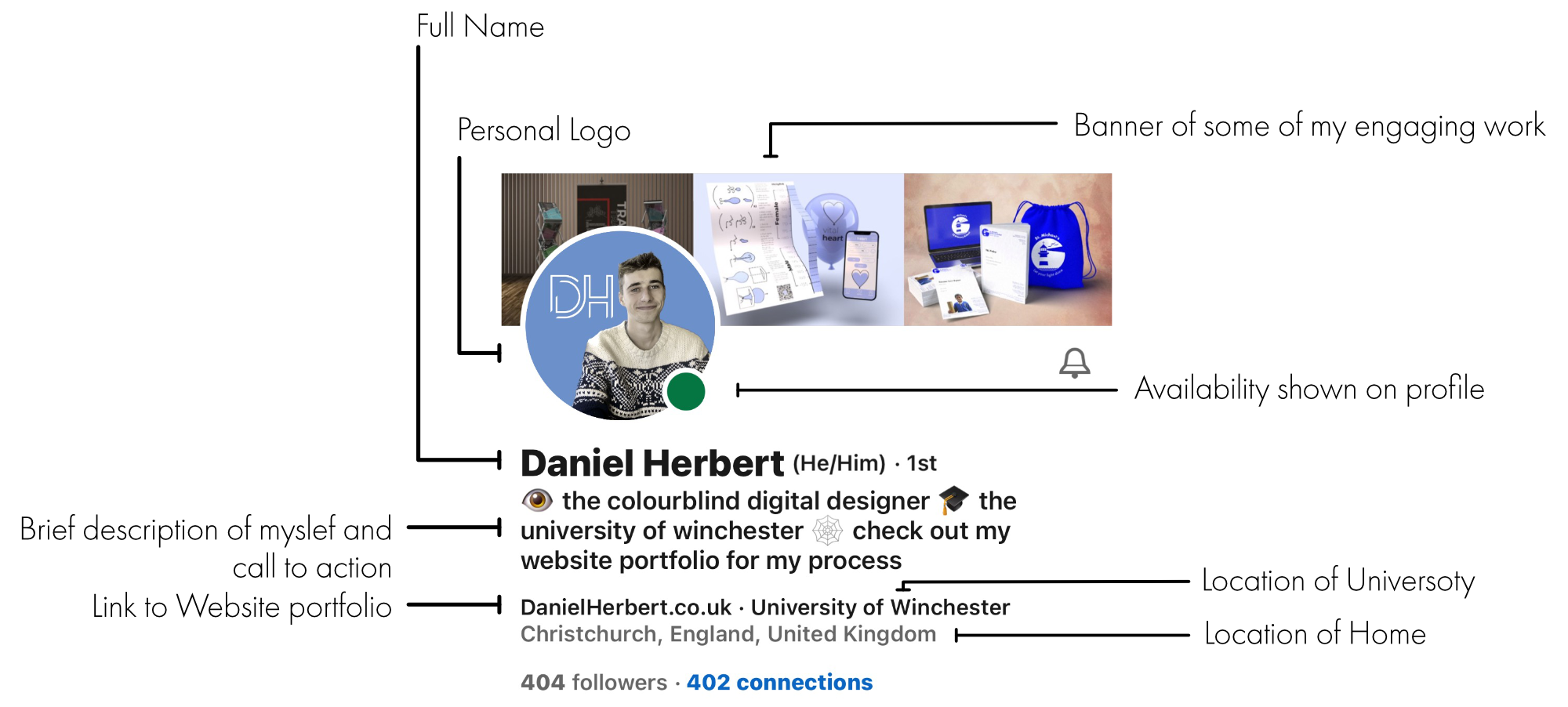
I was keen to use both platforms' communication functions and aimed to receive as many tips, tricks and advice from individuals and companies that I admire. I also aim for the aesthetic of highlights at top of my feed with all my projects colour-coded inline with my posts. Whereas on my LinkedIn I was keen to show my skills and be open to any potential design work. I therefore focused on my CV and used keywords and skills to draw attention to my page.
Instagram
I had a vision at the start of this to keep to a strict colour scheme. I wanted to express myself and my USP, by delivering brands and individual posts on a white background, separated by my large projects with their specific colours, so users could quickly scroll through my profile and find the post they were looking for.
I went into this with 20 posts planned and ready, which was enough for five weeks at my current scheduling timeline, so I decided to change my schedule and post every day for ten days straight.
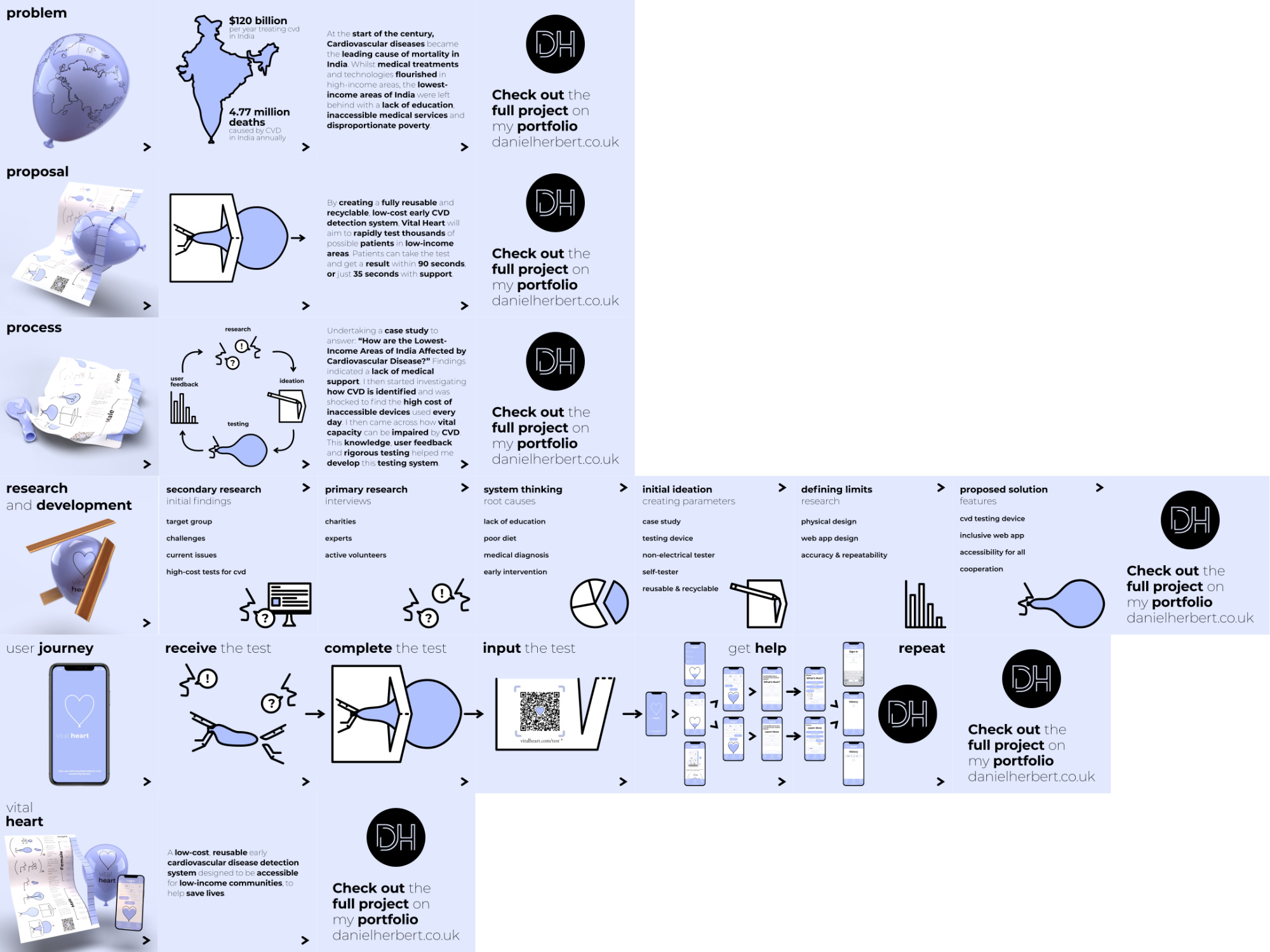
My first three posts consisted of logos from the Brief Club, an Instagram account that posts briefs weekly, which shows increased engagement by up to 200% through research. My following six posts were on my RSA project, and a breakdown of the different steps I took to undertake the project. However I went through many iterations of this as I originally wanted a to have a showcase image on my profile which was cut into six different segments but I found this too messy and confusing for potential clients. I instead created six posts that fully showed the project and the steps I took.
The following six posts consisted of my client projects for this semester.
Unfortunately, Preview doesn't include automatic posting with the budget plan. However, I counted this by creating reminders to post at specific times daily/weekly.
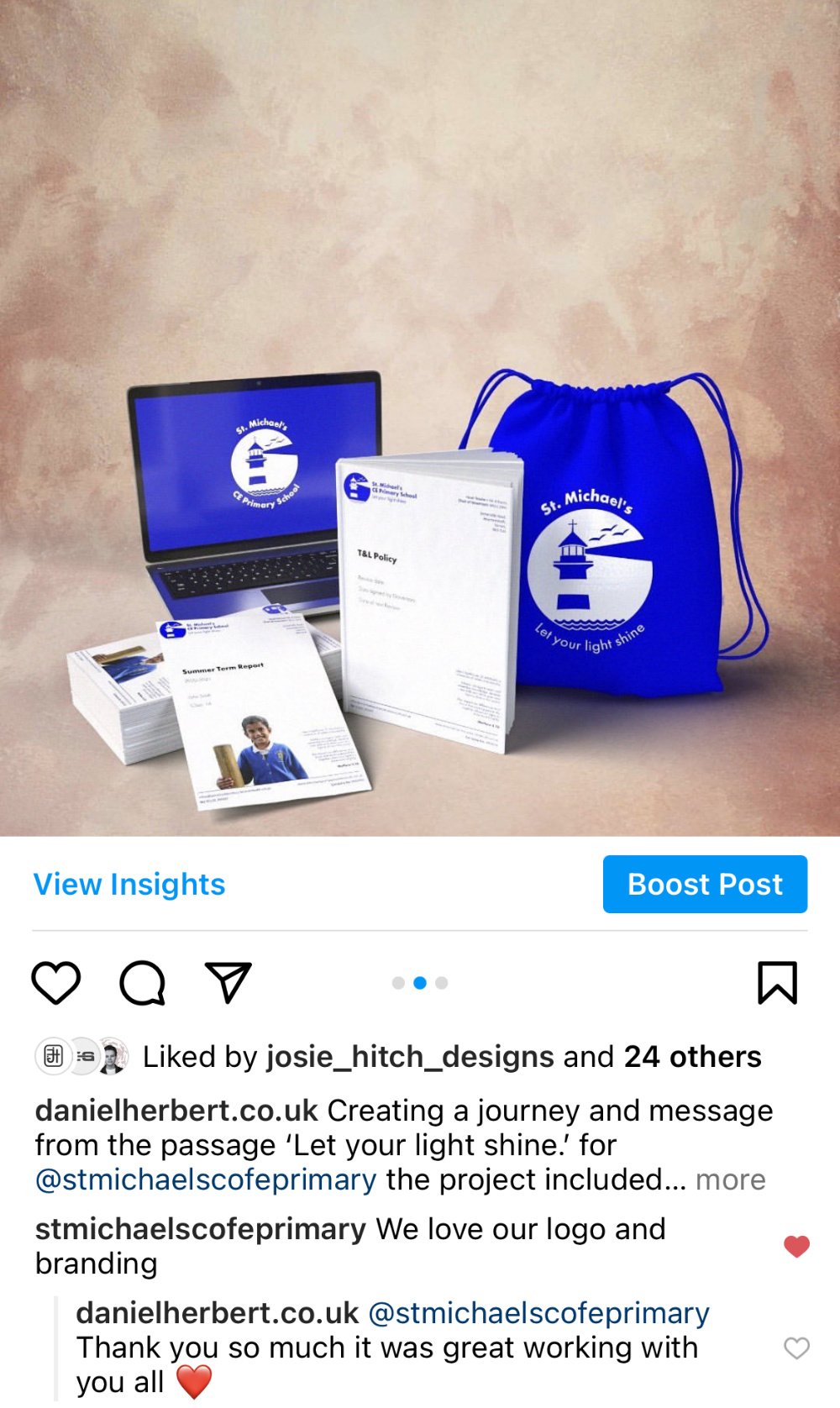
One of my posts was of design work I worked on for a Primary School: St Michaels CofE Primary School. I showed a view of their logo and other assets, including document layouts, PowerPoint templates and brand identity. This received positive comments from individuals and comment from the client's account: "We love your logo and branding", which helps engage possible clients and make me more credible.
I changed my schedule during posting as I had an issue where I did not have my content ready to post; however, I wanted to stick to my brand guidelines and follow my set wireframe. This setback allowed me to take a step back and appreciate the depths and complexity of social media. I had to pause posting for ten days while working on my client project. This break showed a sharp decrease in reach, profile and portfolio visits but also allowed me to have more time to connect with professionals.
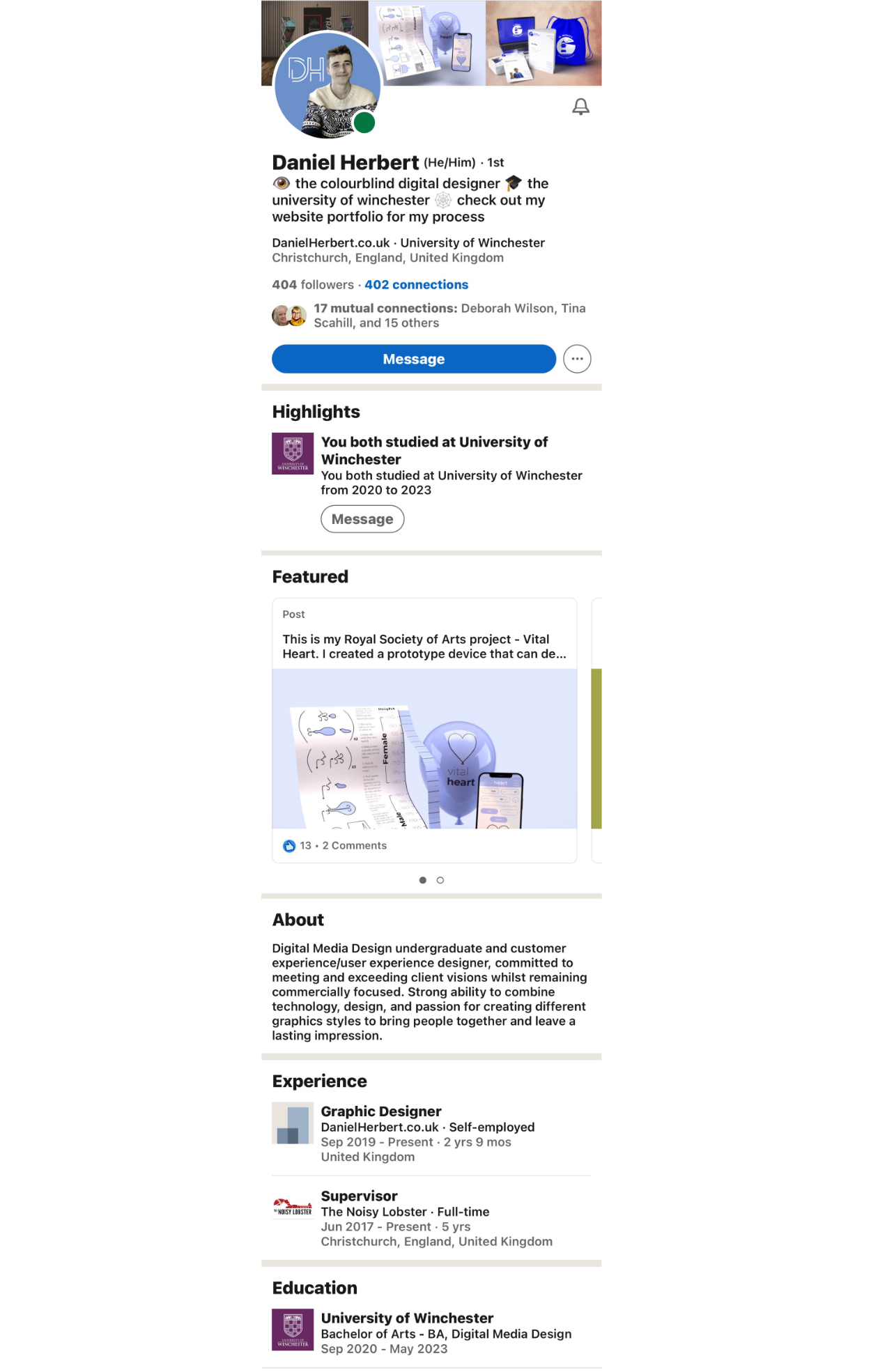
LinkedIn
Meanwhile, on LinkedIn I created my first post which was showing my Vital Heart project, as LinkedIn is directed more towards larger projects to complete, and personal achievements. I also worked on my skills on LinkedIn and uploaded as much software as I felt comfortable using as well as undertaking some tests to get LinkedIn certified on specific software. This allows me to grow on the platform and shows that I am capable of using specific and sometimes niche software.
I also took this opportunity to connect and disconnect with people. I originally started using LinkedIn when I was 17, and at the time, I thought it was a wise decision to connect with over 350 individuals. On reflection, and after researching, I found that this strategy resulted in very few connections that were in the same industry that I wanted to pursue. I took 2 to 3 days to un-connect and un-follow over 250 connections. I then took several more days connecting with individuals who I aspired to work with or admired in the industry as well as companies that I found engaging. Through these connections, I found two UX and Product Designers from BT. I reached out to them and talked to them about their career choices, tips and tricks and even went on to a video meeting with both of them and discussed the opportunity of placement. As BT currently do not offer placements in the design team, I am still unsure whether or not I will be getting any placement; however, they were impressed with my work and offered me weekly mentoring, which has been invaluable.
I also reached out to Rob en Robin and asked about their processes and the feedback on my website. I had a meeting with them for an hour and learnt so much about how to utilise Cinema 4D as well as how to communicate with clients and find the best solutions.
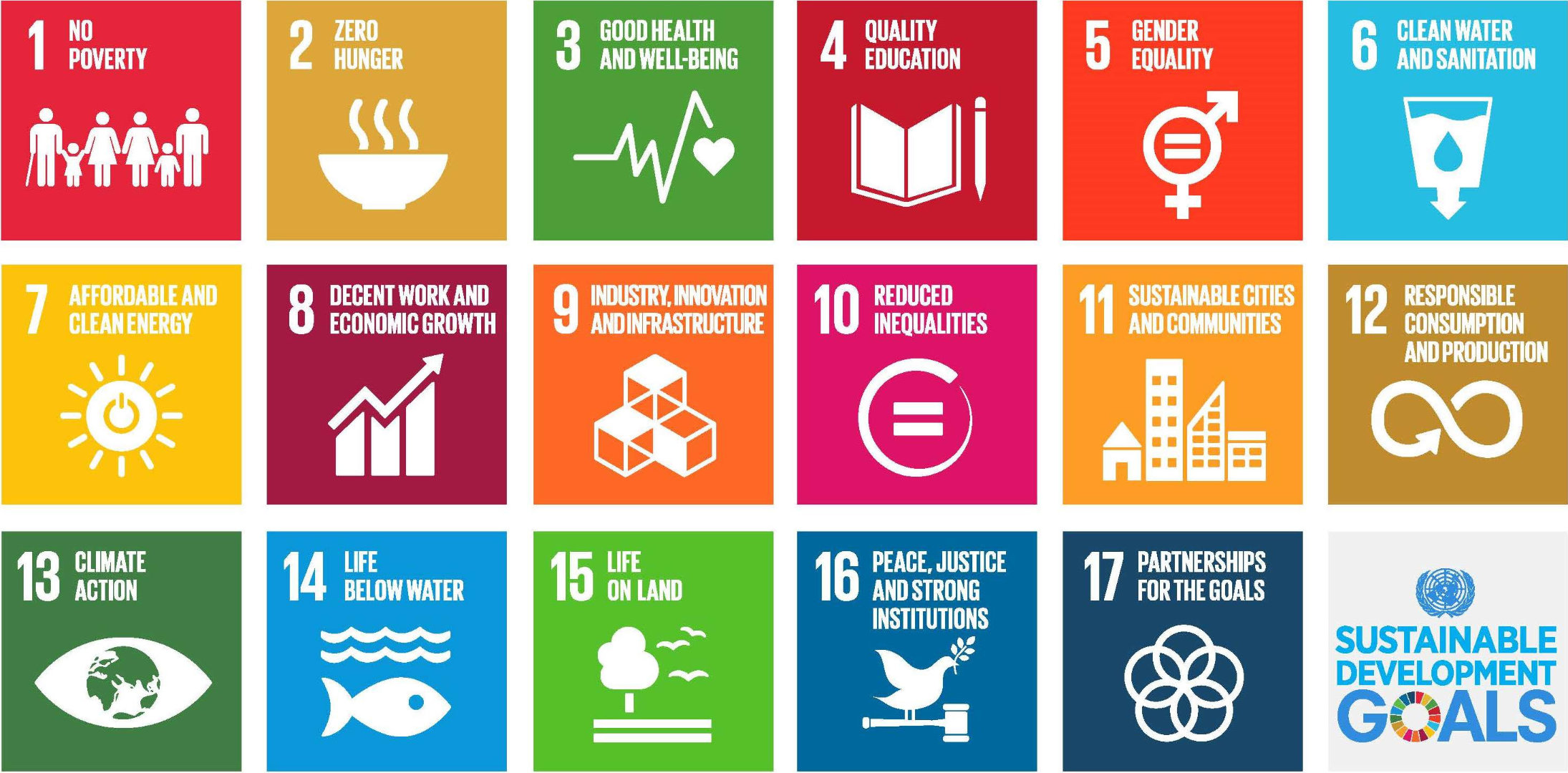
I aimed to enforce and prioritise Sustainable Development Goal 17: Strengthen the means of implementation and revitalise the global partnership for sustainable development.
I used Instagram and LinkedIn features to improve partnerships globally and in the industry by interacting with other posts and sharing projects from people whom I believe should have their work and opinions shared widely. I also composed posts for my RSA project, which aimed to help fight CVD in lower-income areas which also spread the message globally.
Analysis - How have my socials helped me
Instagram
Using an existing design account, I had previous followers, mainly of school friends, but I knew I wanted to shift my followers over to my preferred industry. I took this on straight away before I started posting, but this turned out to be a mistake. I followed and reached out to many designers who inspired me, but with no posts on my page, I received a low response rate, and low follow back rate as individuals may have believed that I was a spam account.
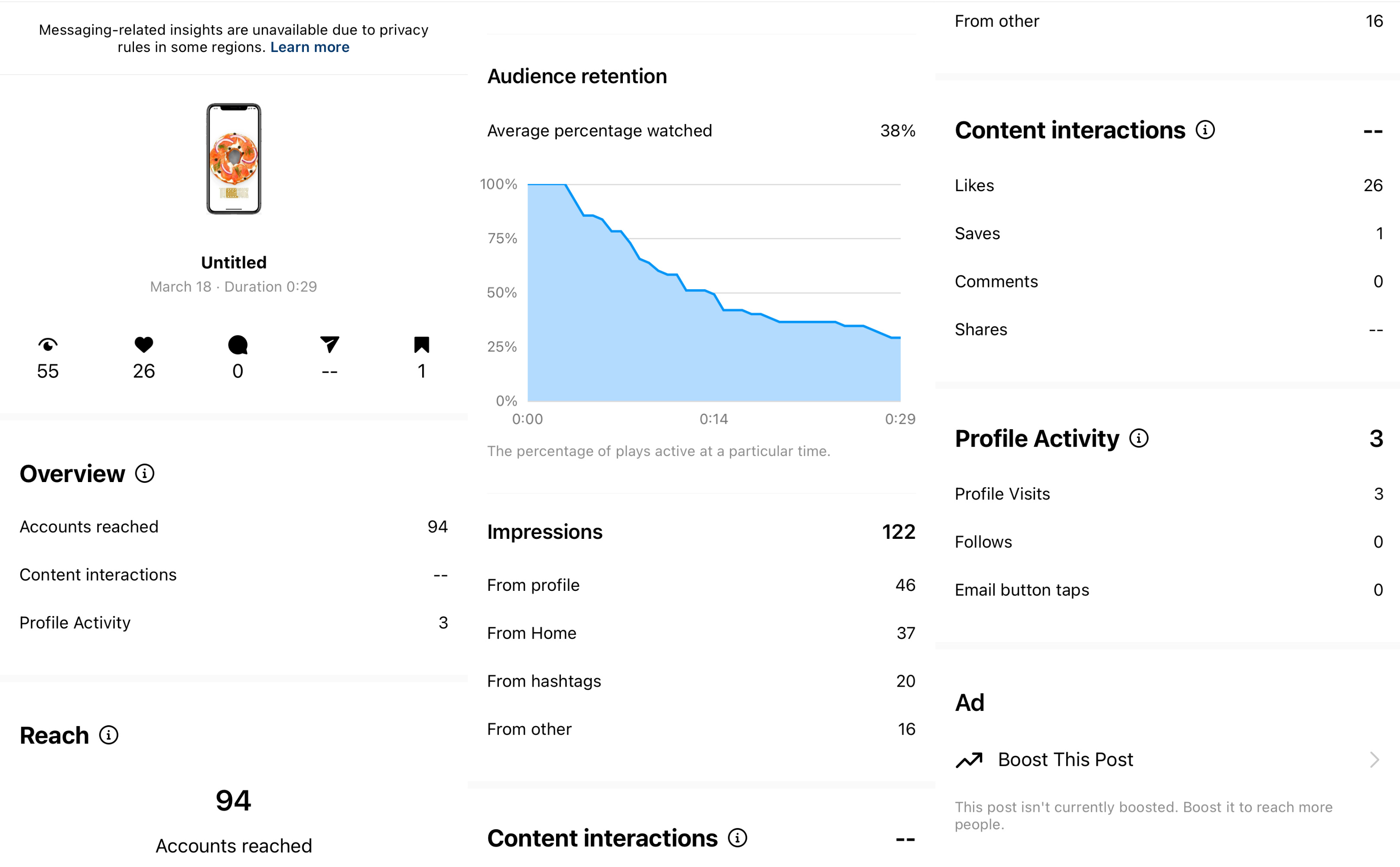
I used different media forms on Instagram during my campaign. Using the video format, I found that retention was better than I expected with a 32-second video. One of the videos included 122 impressions, 20 of which were from hashtags, with the average per cent watched being 38% of the footage; however over 25% of people finished the entire clip, which was a reasonable indication to me that I was reaching the right audience. However this is hard to judge as I had many posts that include videos, but these were embedded into carousel posts so there were not part of insights I could analyse this easily. However, I did find that carousels with videos increased likes by 15% on average which tells me that videos are more engaging and yield a better response rate than a static image.
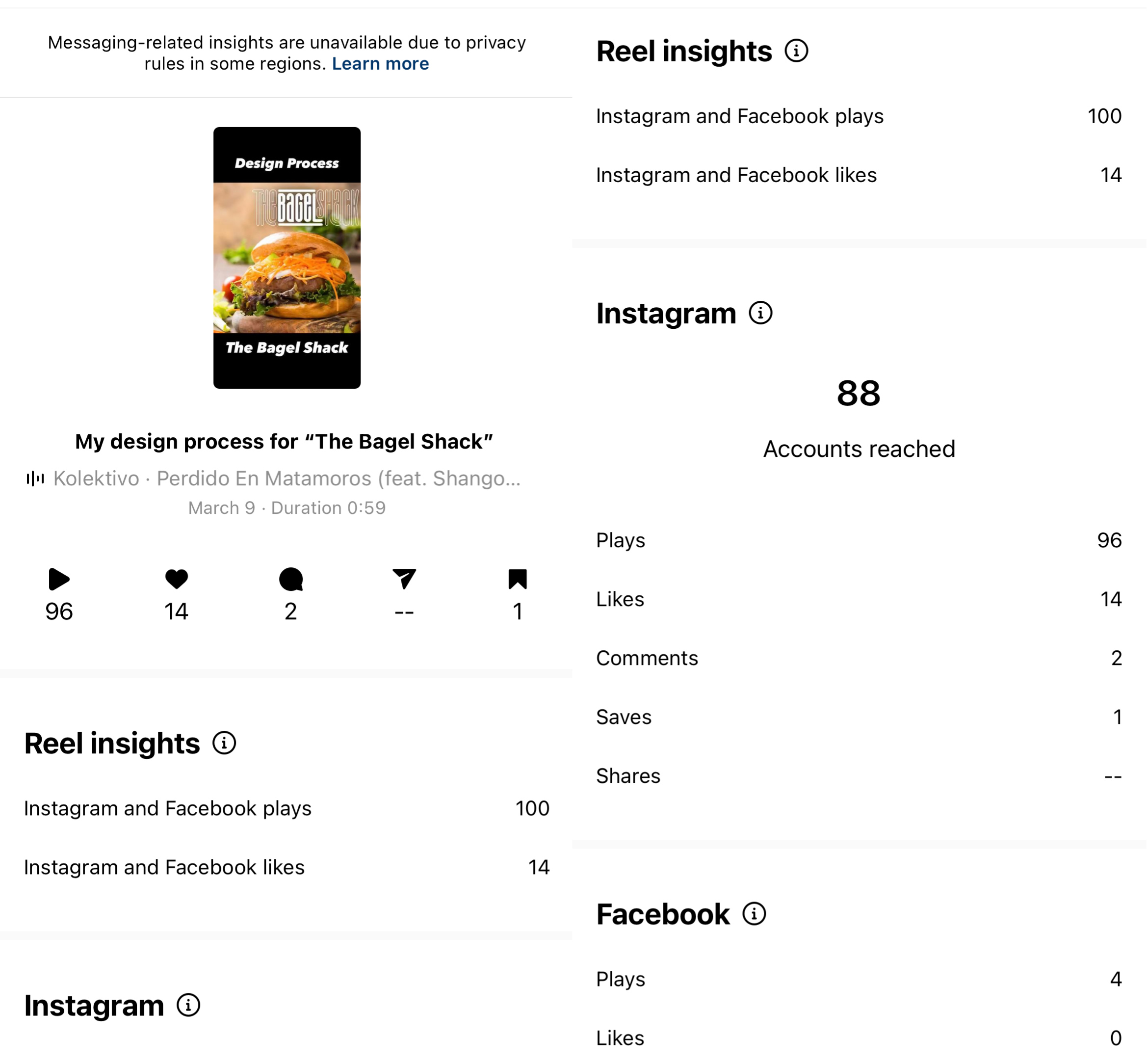
On the other hand, Reels gave back fewer results than videos. I believe this was from hashtags being used as I was not reaching the right audience; however, I reached a total of 88 accounts with 96 plays and several comments as well as a few saved. However, this may be due to the longer format I did used with a reel lasting 60 seconds which is the maximum length of a Reel. My reel is less likely to show up on other people's accounts if the video has not been watched in full or repeated several times by an individual due to the Instagram algorithm. However, I experimented with posting these to Facebook as well, and I received a total of 12 views and four likes on Facebook. I did this as I had no followers or other interactions on Facebook, and I just wanted to see how the algorithm would have affected the post if it was posted purely using the hashtags.
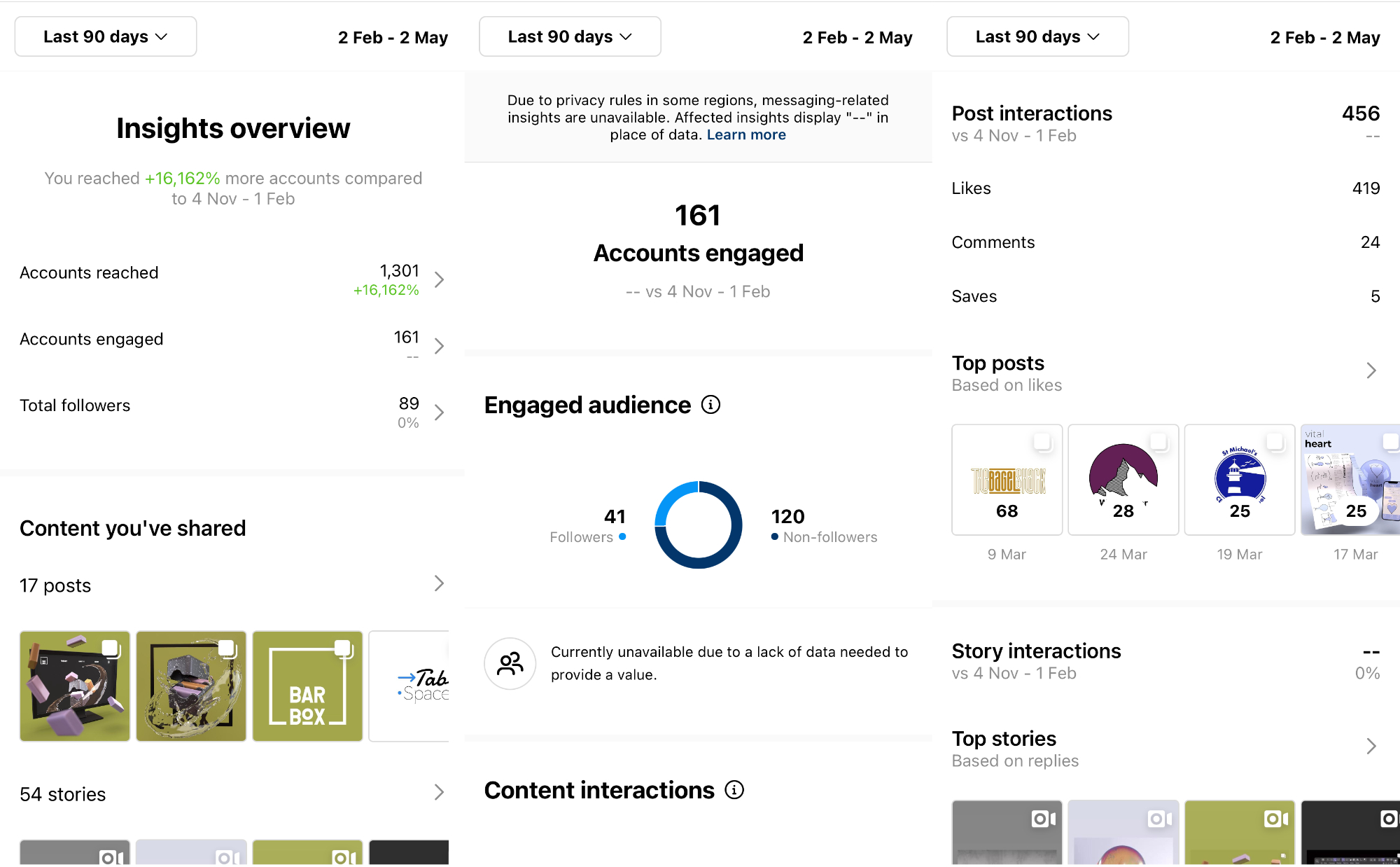
Over the 60 days of posting between March and May I had over 450 post interactions: 419 likes, 24 comments and five saves on 18 posts. My most substantial post was one of my first individual project posts for the Brief Club: The Bagel Shack. I also reached a total of 1300 accounts which means that the ratio of reached accounts to interacting accounts are over 33% showing that I one third of all viewers either liked, commented or saved one of my posts.
I found carousels had the best success in non-following users interacting with my posts compared to my videos and story. At the end of each post, I had a custom message inviting users to view my portfolio website to view the rest of the specific or similar projects. I also have the same message in my caption and an easy-to-navigate link in my profile. The actions that accounted for over 75% of my website visits (according to Google Analytics) included 65 portfolio visits over the two months and 333 profile visits altogether, I believe that reaching almost 400 profile activities was caused by intriguing the user with the call to action and using a familiar style of posts whilst, also giving users new and entertaining designs.
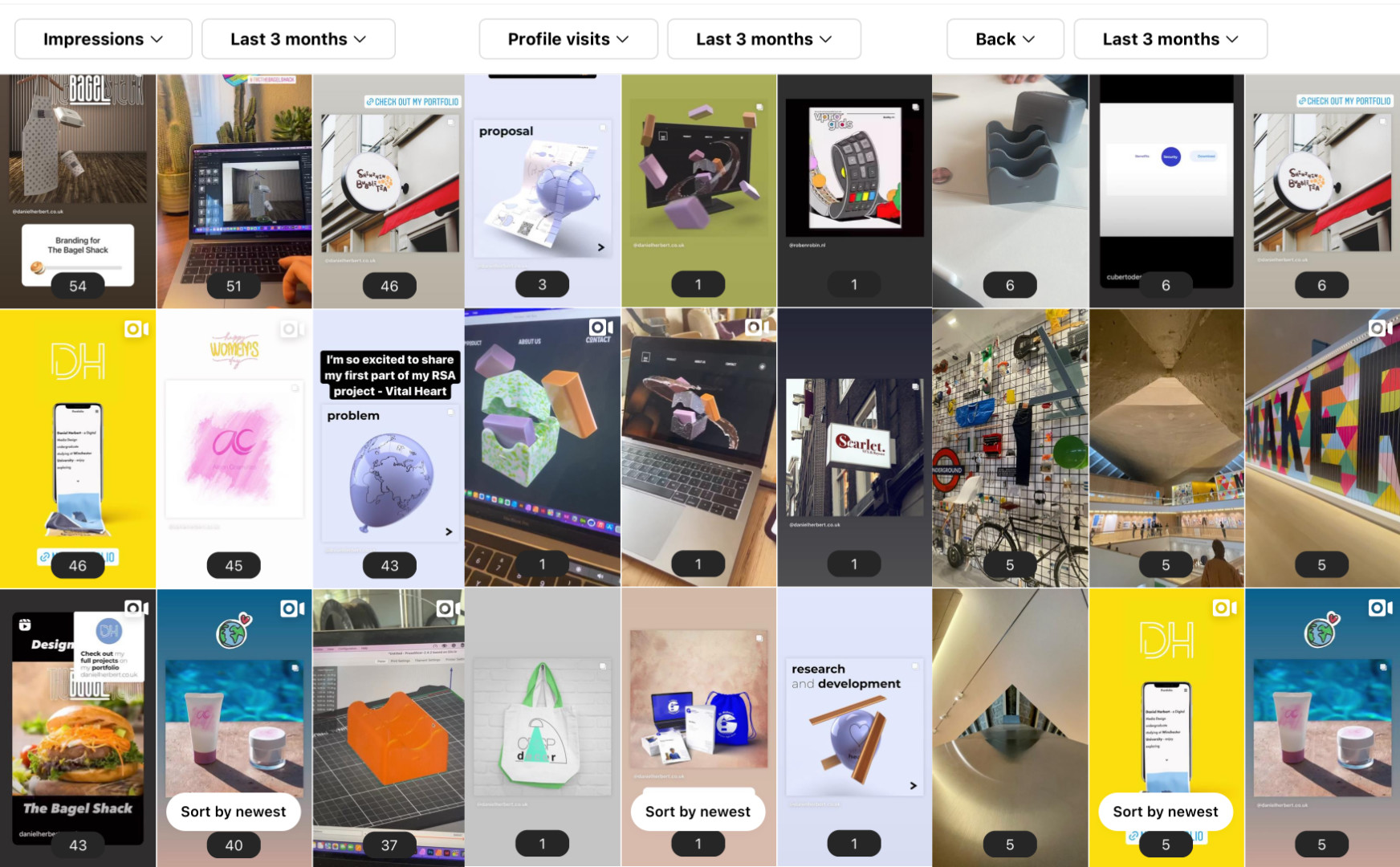
To build engagement, I posted stories at least 7 times a week. By highlighting these stories into groups of projects and themes, I can get more profile visits and increase the length of time that people stay on my profile. For those who wanted to check out my profile for a couple of seconds to find a specific post, they could, as all my projects are colour coded in vibrant colours, which allows them to be easily scrolled through, even when I continue to post in the future.
LinkedIn
A large part of this project had to do with grasping the difference between Instagram and LinkedIn and how LinkedIn is more professional, and more likely to have a lower interaction rate compared Instagram. Despite this, I'm still happy that I got a total of over 30 profile visits during this time of posting and over 45 video views per day of a recent video post. I also showed up on over 15 searches which showed that I was using relevant tags and had completed relevant skills on LinkedIn.
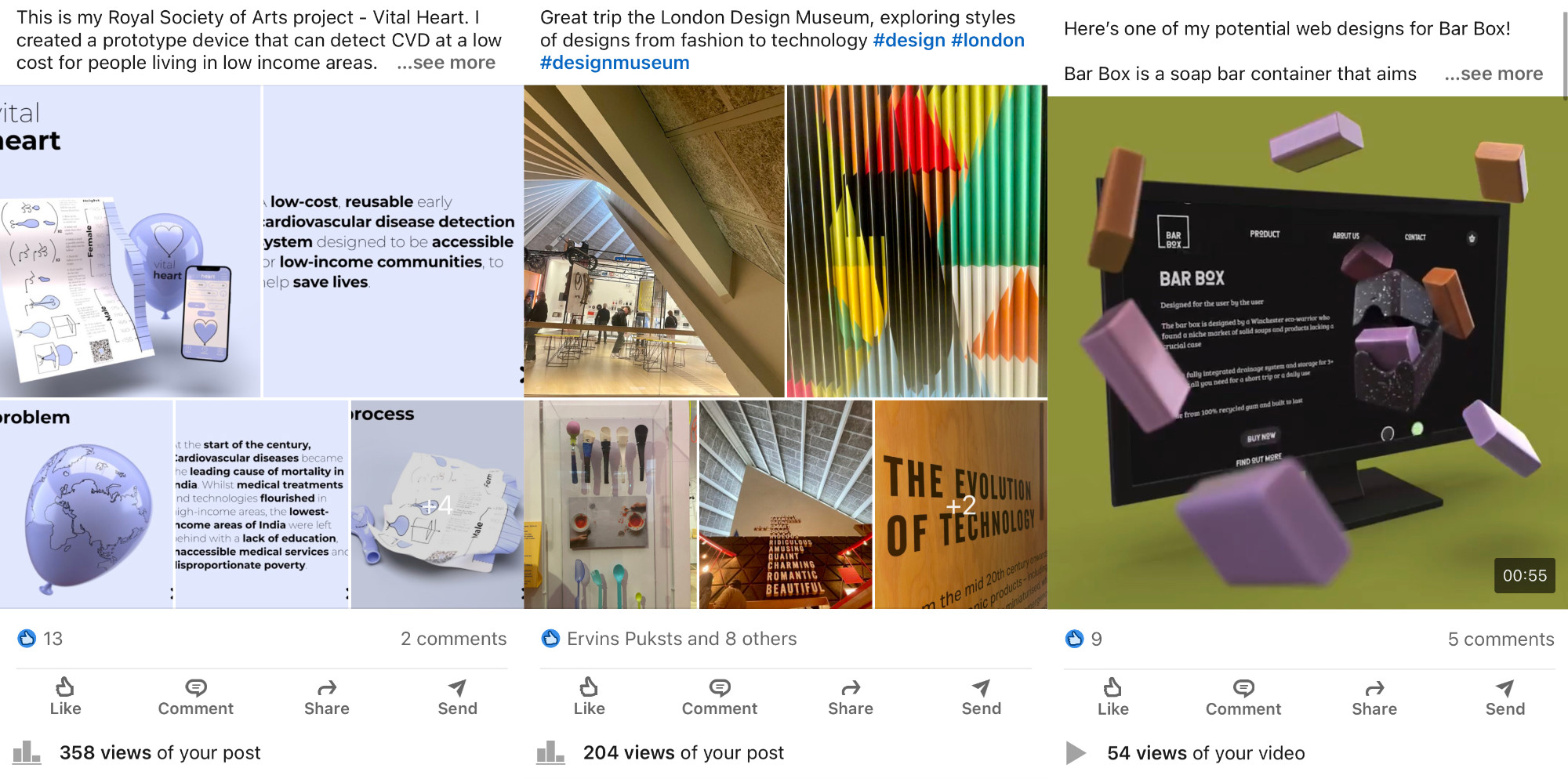
My first LinkedIn post received 347 views which was a great initial post, and four people reached out to me about this post, two in comments and two indirect messages asking about the RSA. In other posts, such as our University trip to The London Design Museum, I received 195 views using limited hashtags and posting at a typically poorer time of day for interaction. On reflection, I could have spent more time at the beginning on improving my LinkedIn profile and posting more continuous on LinkedIn in a similar style to my posts in Instagram. I believe I met most of my SMART goals as I received a placement opportunity within the timeframe of three months as well as creating a relatively complete profile with all my skills and previous work on show.
I'm not sure how the algorithm worked with un-connecting and un-following 200 individuals at the start of February and then following 100 individuals immediately after however, I found this beneficial on a personal level to connect to an amazing group of people whom I wouldn't have had the chance with connect to otherwise.
